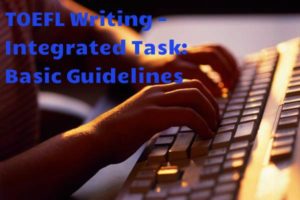TOEFL Writing Integrated Task Tips ①
Written/edited by Rose
留学・ビジネス英語に強い オンライン英会話 マイチューター
▮ TOEFLライティング総合問題 解答文章の書き方
IELTS ライティング総合問題(Integrated Task)では、パッセージを読んだ後、レクチャーを約2分聴いた後で、レクチャーの内容を要約することと、それがどうのようにパッセージの内容と関連しているか(多くは異なる観点)をライティングで表現するテストです。
採点のポイントとなる文章の構成、質問に対して的確な答えになっているに注意してエッセイの書き方を示します。
文の構成(Organization)といいますが、一体どんなことを言っているのでしょう。日本でよく「起承転結」といいます。アメリカではIntroduction, body, conculusion (序論、本論、結論)といいます。TOEFLはアメリカのテストですから、こちらに従います。
-
INTRODUCTION:
>Presents the topic of the essay. What the reading and listening are about.
>Keep it brief, 1-2 sentences will do. Just give a general idea of what the topic is before getting into points of similarity or contradiction.
Examples:
If Contrasting ideas:
“The author explains that ______ (main idea of the reading). The lecturer, however, suggests that ______ (main idea of the lecture).
OR
Adding information:
“The author explains that ______ (main idea of the reading), and the lecturer suggests that ______ (main idea of the lecture).
OR
“Both the reading and the listening talk about ______.”
-
BODY:
>Present the main points and supporting details/contrasting ideas on each point presented
>the number of paragraphs depends on the number of main points and key details presented
>Make sure to write accurate and important information
USE: (Opposition) In contrast to, As opposed to, Directly/blatantly/clearly opposes, this point contradicts, It is the exact/polar opposite of, A conflicting statement, He/she denies this by, It is inconsistent with, on the other hand.
(Similarity) Agrees with, It is consistent with, This supports/sustains, Offers further proof/arguments of the validity, He/she reinforces this idea by, Similarly, In the same manner, In the same context
Also, while these connectors specifically address the “supporting” or “contrasting” themes, do not forget to use other such markers, such as: because, thus, hence, for instance, such as, besides, moreover, in addition, furthermore, however, as well as, first, second, third, etc.
-
Conclusion
>some TOEFL books say it’s not necessary to include a conclusion. But just to be safe, add it if you still have time.
>Rephrasing of the Introduction. 1-2 sentences long, a general concluding sentence restating what you said in your introduction with more specifics.
USE: in conclusion, in summary, to sum up
Examples: “In conclusion, the reading passage offers an overview of the French Revolution. In the listening, the professor explains three possible causes of the Revolution: government debt, heavy taxation, and social unrest.”
Here’s another:
“In summary, while the reading claims that the French Revolution was brought about by the emergence of Enlightenment principles, the professor disagrees. The professor suggests that the Revolution was a result of economic turmoil and social unrest.”









